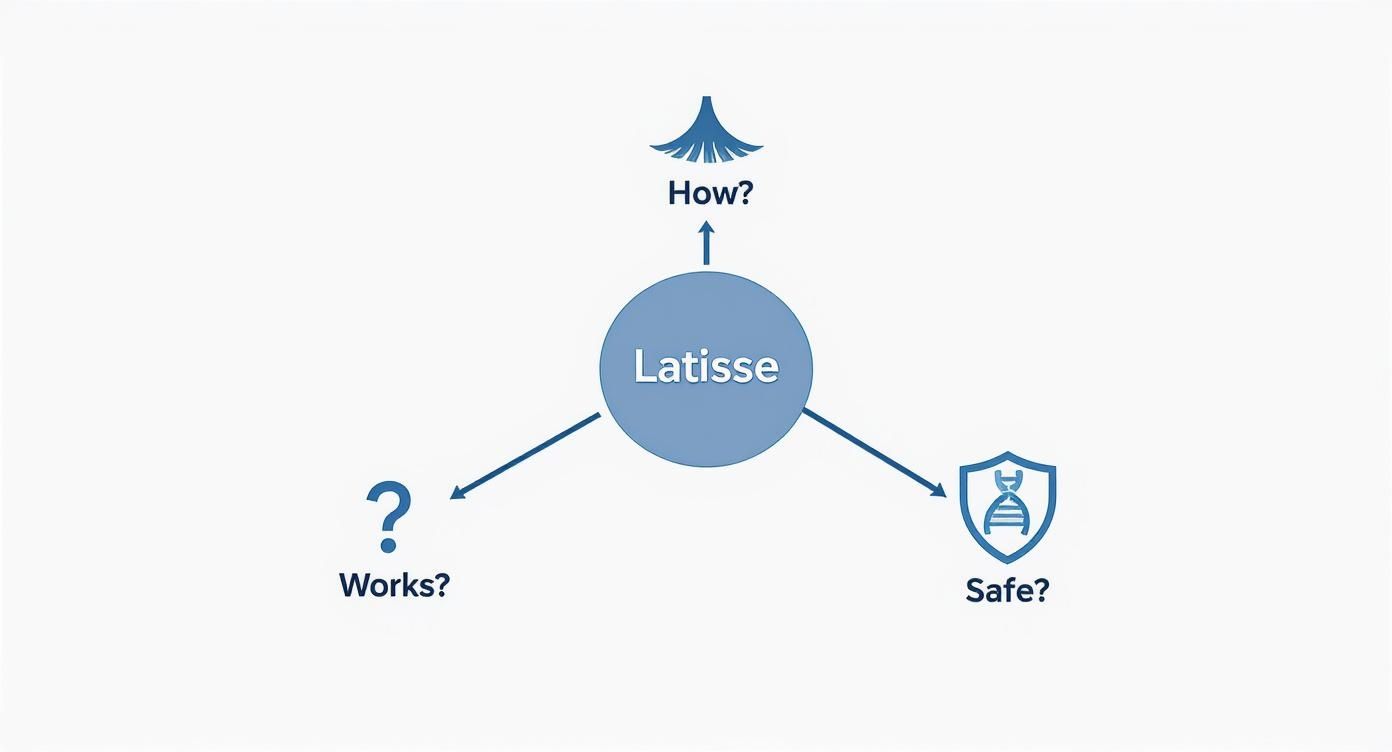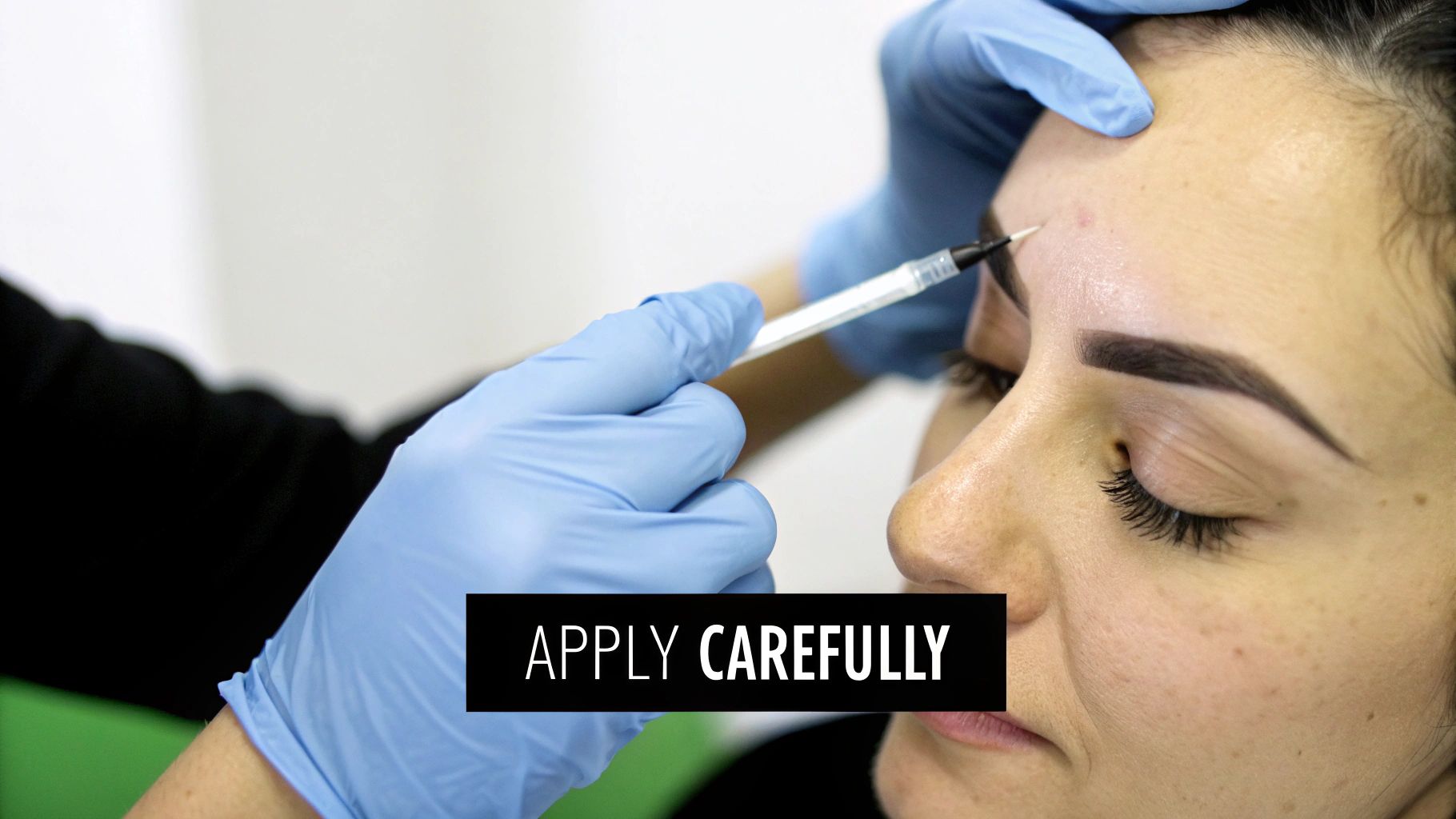
November 22, 2025
Taking Vitamin C Before Surgery An Expert Guide
Considering vitamin C before surgery? This guide covers the science-backed benefits for healing, potential risks, and crucial advice from surgeons.
Nov 21, 2025

Yes, Latisse absolutely can work for eyebrows, but it's important to understand what it is and how it works. While it's only officially FDA-approved for eyelashes, its active ingredient, bimatoprost, has been used successfully "off-label" for years to help people with thinning brows. Think of it as a powerful tool that, when used correctly under a doctor's care, can deliver some pretty impressive results.
Have your eyebrows thinned out over the years? Maybe from over-plucking back in the day, or perhaps it's just a part of aging or genetics. You're definitely not alone. The search for fuller, more defined brows is what leads many people to look past the pencils and gels for a real solution. This is where Latisse comes into the picture.
While its claim to fame is longer eyelashes, the science behind it works on other hair follicles, too—including the ones that make up your eyebrows. Latisse's magic lies in its ability to extend the hair's natural growth phase, what's known as the anagen phase. By keeping more of your brow hairs in this active growing state for longer, it gives them a chance to grow longer, thicker, and even a bit darker.
You'll hear the term "off-label" a lot with Latisse for brows. All this means is that a doctor is prescribing a medication for a purpose other than what the FDA has officially approved it for. It's a very common and perfectly legal practice in medicine when a provider determines that a treatment is a safe and effective option for their patient. For eyebrow thinning, this has become a trusted approach for countless dermatologists and plastic surgeons.
People who use Latisse on their brows are typically hoping to see a few key changes:
For a quick overview of what to expect, here’s a simple breakdown.
This table helps set the right expectations, but a personal consultation is always the best way to understand how it might work for you.
This isn't just wishful thinking or a few good before-and-after photos. There's solid clinical evidence showing that Latisse works for eyebrows. A major study published in the journal Dermatologic Surgery looked at 357 adults with thinning brows. The results were clear: over 77% of participants who used bimatoprost saw significant improvement in eyebrow fullness and darkness. That was a huge jump compared to only 43% who saw improvement in the group using a placebo. You can find more details about the findings of Latisse studies online.
Latisse doesn't create new hair follicles out of thin air. What it does is wake up the dormant follicles you already have, pushing them out of their resting state and back into a productive growth cycle. It’s like a specialized fertilizer for your existing brow hairs, helping them reach their full potential.
Making an informed decision starts with understanding the real science and data. If you're in the Cape Cod area, our experts at Cape Cod Plastic Surgery are here to give you a personalized consultation and help you figure out if this treatment is the right fit for your goals.
To really get how an eyelash serum can work wonders on eyebrows, you have to understand the hair growth cycle. Every single hair on your body, including your eyebrows, goes through a "growing season" known as the anagen phase. The length of this phase dictates how long and thick each hair can get.
If you've always had sparse brows, or they've thinned out over the years, it's often because that growing season is just too short. Hairs pop up, grow for a little while, and then quickly shift into their resting and shedding phases. They never get the chance to reach their full potential.
This is where Latisse comes in. It directly tackles that timing issue. The active ingredient, bimatoprost, is a prostaglandin analog. Think of it as a little signal that tells the hair follicle to stay in that active growing phase for much longer.
By extending this window of opportunity, bimatoprost allows each brow hair to do more than it could on its own. The results are threefold:
This simple infographic breaks down how Latisse works on eyebrows and answers some common questions about what to expect.

As you can see, it’s all about working with your body’s natural hair growth cycle, not against it.
There’s another piece to the puzzle. Bimatoprost also seems to have a knack for nudging dormant hair follicles back to life. Years of over-plucking, the natural aging process, or even hormonal shifts can put follicles into a long-term slumber where they stop producing hair altogether.
Latisse essentially gives these sleepy follicles a wake-up call, encouraging them to get back into the anagen phase and start producing new hairs again. This is key for filling in those frustratingly sparse patches and creating a more even, defined brow line.
It's important to know that Latisse isn't creating brand new hair follicles. It's working with what you already have, pushing your existing follicles to perform at their absolute best for longer than they would on their own.
This two-pronged approach—extending the growth phase and reawakening dormant follicles—is why so many people see real results. It’s a biological solution, not a cosmetic cover-up. Latisse works directly with your hair’s life cycle to produce your own natural hairs, just fuller, darker, and stronger than before. That’s why its off-label use for brows has become such a trusted option in aesthetic medicine. The only way to know if it's right for you is to talk it over with a professional.
While personal success stories are great, the real proof in the pudding for using Latisse on eyebrows comes from solid clinical research. When we look at the hard data, the question "Does Latisse really work on brows?" shifts from hopeful wishing to a confident "yes." Scientists have specifically studied this "off-label" use for eyebrow hypotrichosis—the medical term for sparse or thinning brows—and the findings have been consistently positive.
These studies are so important because they go way beyond subjective before-and-after photos. Instead, they rely on objective, measurable data like hair counts, diameter analysis, and standardized photography. By comparing bimatoprost (the active ingredient in Latisse) against a placebo, researchers can pinpoint its true effect on eyebrow growth.
One of the most significant studies was a large-scale, double-blind, placebo-controlled trial. That’s the gold standard in research because neither the participants nor the doctors know who's getting the real deal versus the placebo, which removes any potential bias. The results? They were pretty dramatic. A clear majority of people using bimatoprost saw statistically significant improvements in overall eyebrow fullness, thickness, and darkness compared to the placebo group.
And this wasn't just a one-off finding. Other smaller studies have echoed these results. One trial with 10 women saw noticeable growth in just six weeks. Another discovered that even a lower-dose 0.01% bimatoprost solution delivered significant growth over six months. This suggests the treatment works well even at a lower concentration. You can dive deeper into the research behind Latisse for eyebrows to see how the data stacks up.
What does "statistically significant" actually mean for you? It means the results weren't a fluke. The improvements were so consistent and substantial that they were almost certainly caused by the treatment itself, not random chance. It’s the scientific seal of approval.
This body of clinical evidence gives us a strong foundation. It confirms that the bimatoprost in Latisse really does kickstart dormant eyebrow follicles in a predictable and measurable way.
Alright, let's talk about what this means for your brows. Based on the clinical data, the journey to fuller eyebrows is a gradual one, with changes building over several weeks of consistent use.
Here’s a realistic breakdown of what the studies show:
The key thing to remember is that these results hinge on consistent, correct application over the full treatment cycle, which is typically 16 weeks. Think of it as a marathon, not a sprint. Every daily application is a step toward your final goal, and the clinical evidence is clear: for those who stick with it under medical guidance, Latisse is a genuinely effective way to get naturally fuller, more defined eyebrows.
Knowing that Latisse can work for eyebrows is one thing, but applying it correctly is what makes all the difference. Since this is an "off-label" use, getting the technique right is key to getting the fuller brows you want while minimizing any potential side effects. The process itself is simple, but your consistency is what will ultimately drive your results.
Think of it like tending to a delicate garden. You need to prepare the soil, apply the fertilizer right at the roots, and do it on a regular schedule. Your goal is to deliver the bimatoprost solution directly to the hair follicles without it wandering onto the surrounding skin.

Consistency is everything here. The best way to succeed is to make applying Latisse a non-negotiable part of your nightly skincare routine, just like brushing your teeth.
Follow these simple steps every single evening for the best possible outcome:
Start with a Clean Slate: Before anything else, your face needs to be completely clean. Take off all your makeup, paying special attention to any brow pencils or powders, and wash your face with a gentle cleanser. Pat the skin and your eyebrows completely dry. Any lingering moisture or product can interfere with absorption.
Prepare the Applicator: Squeeze a single drop of Latisse onto a sterile, fine-tipped applicator. A clean, thin eyeliner brush works perfectly for this, as do the applicators that come with the product. One drop is all you need for both brows, so resist the urge to use more.
Apply with Precision: Gently sweep the applicator along the skin at the base of your eyebrow hairs. You're aiming for the roots, not just painting the hairs. Focus on the areas you want to see growth, whether that’s your entire brow line or just a few sparse patches.
Avoid Cross-Contamination: While you only need one drop, it’s smart to use a fresh applicator for each eyebrow. This is a simple but important step to prevent transferring any bacteria from one side to the other.
Blot Any Excess: This is a crucial final step. Take a tissue and gently blot away any excess solution that may have gotten onto the skin around your eyebrows. This helps prevent potential side effects like skin darkening or hair growth outside of your target area.
To really maximize your results and keep things safe, a few pro tips can go a long way.
It’s important to have realistic expectations about the timeline. The first subtle changes might appear around the 4-6 week mark, but the most dramatic, full results typically take about 16 weeks of consistent daily use to become visible.
Once you’ve hit that 16-week mark and are happy with your brows, your provider will likely switch you to a maintenance schedule. This usually means cutting back the application to just two or three times a week to keep your brows looking full and fantastic. Following this guidance is the key to making your results last.
Latisse is a prescription treatment, and like any effective medication, it’s important to have an honest conversation about the potential side effects. Knowing what to expect helps you make a confident, informed decision.
Thankfully, most side effects are mild, temporary, and pop up right where you apply the product.
The most common reactions are things like mild itching, redness, or a bit of dryness on the skin around your eyebrows. In the original clinical trials for eyelashes, fewer than 4% of people experienced this. For most, these little annoyances fade on their own as their skin gets used to the routine.

Beyond some temporary irritation, there are a couple of other things to keep on your radar. They aren't common, but knowing about them is part of using the treatment safely.
The good news? Both of these side effects are almost always tied to how you apply it. A little product goes a long way. If you use a minimal amount and keep it precisely on your brow line, you can steer clear of these issues.
The most talked-about risk with bimatoprost—the active ingredient in Latisse—is the potential to permanently change eye color, usually turning blue or green eyes brown. Let's put this into proper context.
This side effect was primarily seen when bimatoprost was used as a medicated eye drop for glaucoma (like Lumigan), where much higher doses are dropped directly into the eye itself.
When you're carefully dabbing Latisse onto the skin of your eyebrows, the risk of enough solution getting into your eye to change your iris color is extremely low. As long as you apply it correctly to the brow line, this isn't a significant concern. That said, if you have an existing eye condition, like uveitis, be sure to discuss it with your doctor first.
Understanding these possibilities is just like learning about any other cosmetic treatment. For example, knowing what to expect from injectables is key to a good outcome, something we dive into in our guide to common dermal filler side effects. At the end of the day, nothing beats a one-on-one consultation to weigh the real-world pros and cons for you.
https://www.youtube.com/embed/Rq5Q4CH6s4w
Tempted to try Latisse for your eyebrows? Your first move shouldn't be a Google search for online pharmacies—it should be a conversation with a professional. Self-diagnosing and ordering medication online is a recipe for disappointment and, frankly, it can be risky. A board-certified provider is your partner in getting this right.
Think of them as more than just a gatekeeper for a prescription. A true expert will dig into why your brows are thinning, making sure it isn't a red flag for a different medical issue. They'll also give you the real-world application tips you won't find on the box, ensuring your journey is safe and successful from day one.
Kicking off any new treatment without an expert's green light is never a good idea. A one-on-one consultation allows a professional to look at your specific situation, understand your goals, and give you a realistic preview of what to expect.
Here on Cape Cod, our team at Cape Cod Plastic Surgery is ready to sit down with you for a personal consultation. We’ll help map out an eyebrow plan that truly fits your goals.
Latisse is an incredible tool for boosting your natural brows, but it's not the only game in town. It’s important to see where it fits in with other popular treatments so you can make a decision that works for your lifestyle and the look you’re after.
Choosing the right path for your brows comes down to balancing longevity, cost, daily maintenance, and the final look you want. Whether you're trying to grow your own hair back or create a perfectly sculpted shape from scratch, there’s a solution out there.
Here’s a quick rundown of the most common options:
Each of these methods has its own set of pros and cons. While Latisse helps with growth, some people might also be addressing concerns like droopy eyebrows, which requires a different approach. Likewise, for those considering surgical options for the entire upper face, learning about a brow lift can offer valuable insights. Ultimately, the best choice is a personal one, and a professional consultation is the perfect place to explore all your options.
Even after learning the science, a few practical questions always pop up when people are thinking about using Latisse for their eyebrows. Let's get right to the most common ones.
This is a great question. If you stop using Latisse, your eyebrows will eventually go back to how they were before you started. It's not a permanent change.
The key ingredient, bimatoprost, works by keeping your brow hairs in their active growth phase for longer. Once you stop applying it, that effect wears off. Your brow hairs will finish their super-charged growth cycle, shed naturally, and be replaced by new hairs on your body's original, shorter schedule. This transition usually takes a few weeks to a couple of months.
That's why, to keep your amazing results, most providers will suggest a maintenance plan after the initial 16-week treatment—maybe applying it just two or three times a week.
Yes, absolutely! In fact, Latisse and microblading can be a fantastic combination. They work together beautifully because they do two different things.
Using Latisse can make your microblading look even better and far more natural. When your own hairs grow in among the microbladed strokes, it adds a real, three-dimensional texture that you just can't get from pigment alone. The only rule is to wait until your skin has completely healed from the microblading session before you start applying Latisse.
The price tag can change depending on where you are and which pharmacy you go to, but you can generally expect a one-month supply to cost somewhere between $120 and $150.
Because using Latisse for eyebrows is an "off-label" cosmetic treatment, insurance will not cover it. While it's certainly an investment, many people find it's worth it when they add up the money and time they spend on brow pencils, powders, and gels every single day.
The best way to get a clear picture of the costs and decide if it's the right move for you is to talk with an expert. When you're ready, our guide on finding a qualified plastic surgeon can point you in the right direction.

November 22, 2025
Considering vitamin C before surgery? This guide covers the science-backed benefits for healing, potential risks, and crucial advice from surgeons.

November 21, 2025
Does Latisse work for eyebrows? Get the science-backed answer. We explore results, proper use, side effects, and what to expect from this popular treatment.

November 21, 2025
A Comprehensive Overview of Body Contouring: Techniques, Benefits, and Recovery